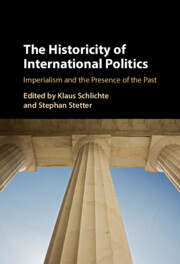Book contents
- The Historicity of International Politics
- The Historicity of International Politics
- Copyright page
- Contents
- Figures
- Contributors
- Acknowledgements
- Introduction
- Part I The Imperial Past and Present in International Politics and IR
- Part II Historical Sociology and the Imperial Fundaments of International Politics
- Part III Global History and the Imperial Fundaments of International Politics
- 11 Unearthing the Coloniality in the International through the Genealogy of IR in Japan and Beyond
- 12 Was the Rise of the ‘Third World’ a Theory Effect?
- 13 The Past and Its Presence in Ottoman and Post-Ottoman Memory Cultures
- Conclusion
- Index
- References
11 - Unearthing the Coloniality in the International through the Genealogy of IR in Japan and Beyond
from Part III - Global History and the Imperial Fundaments of International Politics
Published online by Cambridge University Press: 29 June 2023
- The Historicity of International Politics
- The Historicity of International Politics
- Copyright page
- Contents
- Figures
- Contributors
- Acknowledgements
- Introduction
- Part I The Imperial Past and Present in International Politics and IR
- Part II Historical Sociology and the Imperial Fundaments of International Politics
- Part III Global History and the Imperial Fundaments of International Politics
- 11 Unearthing the Coloniality in the International through the Genealogy of IR in Japan and Beyond
- 12 Was the Rise of the ‘Third World’ a Theory Effect?
- 13 The Past and Its Presence in Ottoman and Post-Ottoman Memory Cultures
- Conclusion
- Index
- References
Summary
This chapter identifies the notion of the International as the core concept of the inter- (nation) state system, which had so far defined the disciplinary knowledge of IR. It argues that Euro-centricity of the disciplinary knowledge of IR is closely connected to this inter-state-centred notion, which had become ‘a-colonial’ and ‘apolitical’, and that an historical unearthing of its neglected colonial legacies is crucial for globalizing this knowledge. The chapter, therefore, pays an attention to neglected imperial polities, and suggests two ways for retrieving them. First, it suggests the framing of inter-imperial/inter-colonial, which could capture complex lateral relationships across diverse forms of imperial polities, and which had otherwise been missed by the framing of inter-national. Second, it locates colonial policy studies in the genealogy of IR in Japan, and suggests its ambiguous legacy for the disciplinary knowledge of IR after World War II in Japan, and possibly beyond.
- Type
- Chapter
- Information
- The Historicity of International PoliticsImperialism and the Presence of the Past, pp. 227 - 246Publisher: Cambridge University PressPrint publication year: 2023



